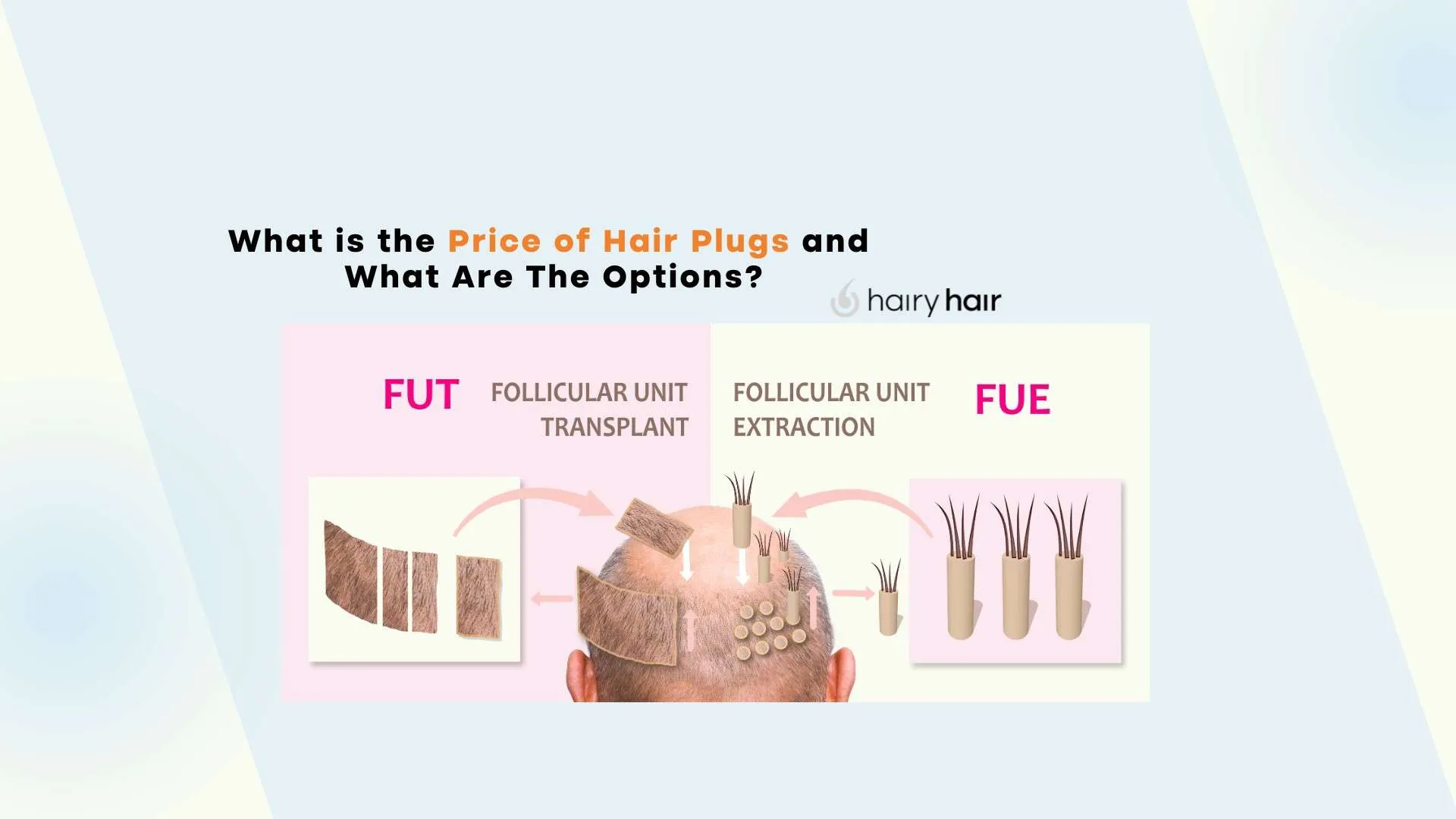What is the Price of Hair Plugs and What Are The Options?

Hair loss can have a significant impact on self-esteem, leading many people to search for effective hair restoration solutions. Hair plugs or hair transplants are types of hair restoration surgery that help combat hair loss and regain confidence. Hair transplants have significantly evolved as a result of medical advancements, offering natural-looking results and various techniques that can be tailored to individual hair loss needs. One of the most common concerns when considering hair transplant surgery is the cost of treatment. In this article, we’ll discuss the types of hair transplant procedures available, as well as the factors that influence costs. By understanding the prices and options, you can make informed decisions about the best approach to your hair restoration journey.
What Are Hair Plugs?
Hair plugs were one of the first surgical procedures developed to treat hair loss. The procedure involves transporting groups of hair follicles from a donor area to balding or thinning areas. The term “hair plugs” is now largely outdated, but modern hair transplant techniques like Follicular Unit Extraction (FUE) and Follicular Unit Transplantation (FUT) have refined the approach, leading to more natural-looking results and minimal scarring. Hair transplantation is typically performed to address thinning hair from conditions like male pattern baldness, or androgenetic alopecia, but it can often be used to tackle other forms of hair loss.
Types of Hair Transplants
There are two main types of hair transplant techniques. A hair transplant consultation with a specialist will confirm the most effective treatment for your specific needs.
Follicular Unit Transplantation (FUT)
FUT, also known as the strip method, involves removing a strip of scalp from a donor area, usually at the back of the head. The strip is divided up into small grafts that contain one to four hair follicles, which are then implanted into the area affected by hair loss. Hair begins to grow approximately 3 to 4 months after the FUT procedure. While it is initially fine and delicate, as the hair grows longer, it becomes thicker and stronger, achieving the same quality as the donor area. Patients often require a few rounds of FUT to achieve the desired final density, which can impact the overall cost. Overall, the FUT hair transplant is known as an effective hair loss treatment technique for providing natural-looking results while optimising scalp hair density.
Follicular Unit Extraction (FUE)
FUE is another hair transplant procedure that involves extracting individual hair follicles directly from the donor area with a small punching tool. The follicles are then transplanted into the recipient area. Initially, this technique was not widely accepted by many clinics due to the difficulty of extracting intact follicles with small punches. However, with the increasing patient demand for effective treatment, availability of improved hair transplant tools, and better surgical expertise, FUE has become a recognised alternative to FUT. While it’s a more time-consuming procedure, it has several advantages over FUE. Because it’s minimally invasive, it often leads to shorter recovery times, less discomfort, and barely visible scarring.
Factors That Affect Hair Transplant Costs
So how much does a hair transplant cost in Australia? The answer is it depends on several factors, such as the type of procedure you choose and the extent of hair loss. Let’s take a look at some of the main factors that impact hair transplant costs.
Type of Procedure
The type of hair transplant procedure, whether FUT or FUE, affects the overall cost. Generally, FUE is the more expensive option as it is a more time consuming procedure that requires a high level of precision and skill.
Extent of Hair Loss
More extensive hair loss requires more hair grafts to cover a wider area of balding or thinning. The cost of hair transplantation is often calculated per graft, so the more grafts needed, the higher the overall cost.
Clinic Location
The location of a clinic is a significant factor in determining hair transplant costs. Reputable clinics in large cities have a high demand for cosmetic surgery, so they often charge more due to higher overheads. Clinics in smaller towns or less populated cities might offer lower prices, but expertise could be more limited, so it’s worth doing your research before committing.
Surgeon’s Expertise
Highly skilled, expert surgeons generally charge more for their service due to their ability to deliver excellent results. Surgeons with a strong track record in hair restoration surgeries and advanced techniques require a higher fee, and it’s often worth paying the extra to achieve natural-looking results and a better patient experience.
Additional Costs
Extra costs may include more grafts and post-operative care such as medications and follow-up appointments. It’s crucial to bear this in mind when planning for hair transplants as costs can add up quickly if you don’t take everything into account.
Price Range for Hair Transplants
Here is what you can usually expect to pay for a hair transplant in Australia. Total prices can vary widely based on the factors above. Remember, many clinics offer payment plans to make things more affordable and help you spread the costs out over time.
FUE Hair Transplant
- Price per graft: $4 to $10
- Total cost: $4,000 to $20,000
FUT Hair Transplant
- Price per graft: $3 to $8
- Total cost: $4,000 to $15,000
Alternative Hair Loss Treatment Options
While a successful hair transplant is often an excellent way to restore hair and self esteem, there are other hair loss treatment options available if you want to avoid surgery. These are some of the most common treatments that can be effective for managing hair loss.
Medications
Medications like minoxidil and finasteride have been clinically proven to slow down hair loss and stimulate regrowth. Minoxidil is available over the counter as a topical solution or foam, while finasteride is a prescription-only medication.
Hair Growth Supplements
Hair growth supplements are designed to nourish hair follicles from within. They contain key ingredients like biotin, vitamin D and omega-3 fatty acids that promote scalp health and support hair growth.
Low Level Light Therapy (LLLT)
This method uses red light or near-infrared light to stimulate hair follicles and encourage hair growth. It’s a non-invasive treatment that works to boost cellular activity in the scalp. LLLT has been shown to provide similar effectiveness to minoxidil.
Scalp Micropigmentation
Scalp micropigmentation is a non-surgical procedure where small pigments are applied to the scalp to create the appearance of hair follicles. It’s more appropriate for people with extensive hair loss or bald patches and can provide the illusion of fuller, thicker hair.
Lifestyle Changes
Certain lifestyle adjustments can improve your overall hair health and reduce thinning. Eating a healthy diet rich in vitamins and minerals helps to nourish hair follicles, while keeping your stress levels low can help prevent stress-induced hair loss. Take care of your hair by avoiding harsh treatments, tight hairstyles and excessive heat styling.
Hair Loss Treatment Plans
Long-term hair loss solutions like the Hairy Hair treatment plan are ideal if you’re looking for a clinically proven, convenient and affordable way to manage hair loss. The carefully formulated pill is designed to deliver long-lasting, effective hair growth results, with no clinic visits required. Sign up for a subscription today and begin your hair restoration journey.
Final Thoughts
Hair transplant surgery remains a top choice for those experiencing hair loss and balding. The procedure is an effective treatment that results in fuller, thicker hair. However, it can be time-consuming and expensive, depending on various factors such as the number of hair grafts required and the clinic’s location. To ensure you have realistic expectations, make sure to carefully consider your options, including the type of procedure. Get an accurate cost estimate based on the above factors, and check that you’re attending a reputable clinic. If you’re not sure whether a hair transplant is right for you, there are plenty of other treatments available that you can try first.
In This Article
Overview
Most Trending Articles


